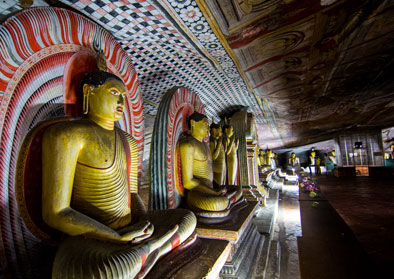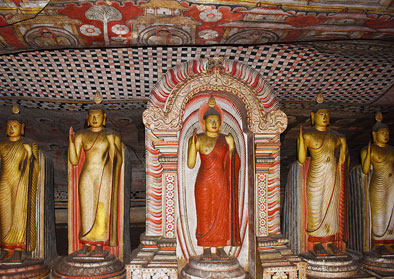Dambulla Cave Temple
Also known as the Golden Temple of Dambulla, the Dambulla Cave Temple is a World Heritage Site in Sri Lanka. Situated in the central part of the country, it is the largest and the best-preserved cave temple complex in Sri Lanka. With more than 80 documented caves in the surrounding area, the major attractions are spread over five caves, which contain statues and paintings.


Caves and Paintings of Dambulla
There are five caves in Dambulla Temple, and all of these caves have various statues of Buddha. There are a total of 150 Buddha images in these caves. The place is a mine of decorative designs, the patterns of which resemble those of Sigiriya. The frescoes that adorn the cave of Dambulla represent the new school of Sinhalese painting.
Cave No. 1 (Deva Raja Viharaya)
It is believed that the cave is named so because the God Sakka (King of Gods) gave the finishing touches to the principal image of this cave. The cave has an image of Buddha, depicting his last moment. In the typical style, the image is about forty seven feet in length. It is carved almost in the round from the natural rock to which it still remains joined all along from behind, and is well preserved.
Cave No. 2 (Maha Raja Viharaya)
The cave is alled Maha Raja Viltaraya because, as per popular belief, the founder of the cave was King Vattagamani Abhaya, who personally assisted in its formation. The cave is painted in brilliant colours and every part of it is in good repair. It is one hundred and seventy-two feet in length, seventy-five in breadth, and twenty-one feet in height. The majority of the statues are of Buddha in different attitudes.
Cave No. 3 (Maha Alut Viharaya)
Also known as Maha Alut Viharaya Cave, most of the new paintings and renovations of the temple are attributed to this last great benefactor of Dambulla. These frescoes depict various and numerous events of Buddhists, some representing the life of the Enlightened One, and score the history of Buddhism. The artistic tradition of this cave is that of the Kandyan period. This cave contains fifty figures of the Buddha.
Cave No. 4 (Paschima Viharaya)
The cave is called the Paschima Viharaya, and is about fifty four feet long and twenty-seven wide; and its shelving roof, which dips rapidly inwards, is about twenty-seven feet high. The cave contains ten figures of the Buddha, and the principal image which is under a torana is of the same size as the other statues.
